-
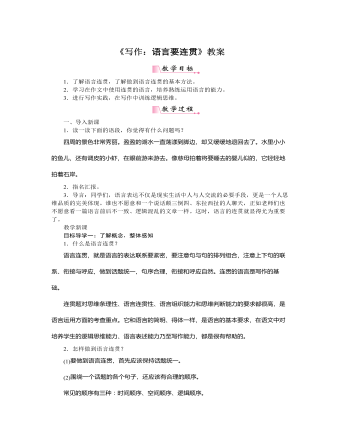
部编版语文八年级上册《写作:语言要连贯》教案
(3)也可以用散文的形式将某一个传统节日的历史渊源娓娓道来,从宏观层面追溯千年历史。2.佳作欣赏节 日在一阵阵爆竹声中,一阵阵欢歌笑语中,我们终于迎来了春节!春节,是中国最盛大的节日,也是我们最高兴的日子。家家张灯结彩,街面上修饰一新,一派喜气洋洋的景象。爸爸妈妈也早早地把家里布置一新,置办了年货,我幸福地眨着眼睛,穿着新衣服在大衣柜镜子前照来照去,真是美极了!大年三十,爸爸领着我把鲜红的对联贴在院门上,那喜庆的金字映衬得我家满院都生辉了。最温馨的是除夕晚上,全家围坐在一起吃着香气四溢的年夜饭,看着异彩纷呈的春晚节目……心中感到是那样的温暖。

部编版语文七年级上册《世说新语》二则教案
?目标导学二:理解内容,体会写法 1.文章开头一句“谢太傅寒雪日内集,与儿女讲论文义。”这句话在全文中有什么作用? 涵盖事件时间、地点、人物及主体事件等丰富的内容。正因为“寒雪日”“俄而雪骤”,才能引出“咏雪。2.“寒雪”“内集”“欣然”“大笑”’等词语营造了一种怎样的家庭氛围?营造了一种融洽、欢快、轻松的家庭氛围。3.“咏雪”的过程中,文章特别记载了两个人的咏,即用“撒盐空中”和“柳絮因风起”来比拟“大雪纷纷”,你对其中哪一个更欣赏?为什么?“柳絮因风起”更好,因为柳絮比盐更像雪。给人以春天即将到来的感觉,意蕴强,有美感,这是“撒盐空中”所缺乏的。“撒盐空中”比喻了雪的颜色。 4.文章结尾交待了谢道韫的身份,有什么用意?谢太傅对两人的答案未做评定,只是“大笑乐”而已,十分耐人寻味。作者也没有表态,却在最后补充了道韫的身份,这是一个有力的暗示,表明他赞赏道韫的才气。
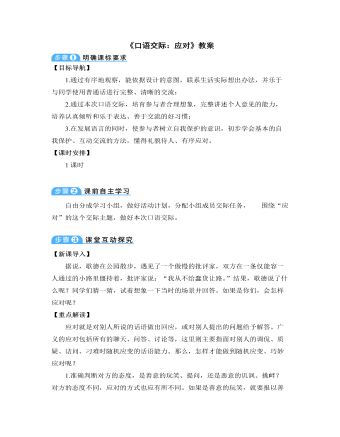
部编版语文八年级下册《口语交际:应对》教案
【研讨练习】题一:阅读下边的应对案例,简要说明这些名人采用了什么应对技巧。1.孔融十岁的时候就表现出超乎寻常的聪明才智,得到人们的赞许。有一个叫陈的官员却当众不以为然地说:“小时了了(聪明),大未必佳。”孔融立即回应道:“想君小时,必当了了。”2.一名英国女士非常喜欢钱钟书的小说《围城》,于是打电话给钱钟书请求见面。钱钟书对她说:“假如你吃了个鸡蛋觉得不错,何必认识那下蛋的母鸡呢?”3.一个年轻的画家拜访德国著名的画家阿道夫·门采尔,向他诉苦说:“我真不明白,为什么我画一幅画只用一会儿工夫,可卖出去要整整一年。”“请倒过来试试吧,”门采尔认真地说,“要是你花一年的工夫去画它,那么只用一天就准能卖掉它。”________________________________________________________________________________________________________________________________________参考答案:1.针锋相对2.归谬3.自嘲题二:在我们的生活当中,经常会碰到别人有意的嘲讽。阅读下面的情境,机智应对。
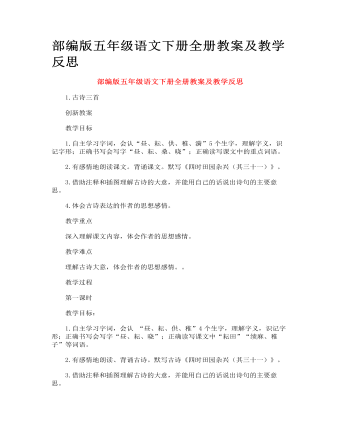
部编版五年级语文下册全册教案及教学反思
初读古诗,整体感知。 1.请同学们用自己喜欢的方式读古诗《四时田园杂兴》(其三十一)。要求借助拼音学会生字,把古诗读正确,读通顺。 2.指名多个学生朗读古诗,师生评议,纠正读得不准确的字音。尤其注意读准“昼、耘”的读音。指导读准多音字“供”([ gōng ]作动词时,准备着东西给需要的人应用:供应、供给(jǐ)、供求、供需、供销、提供、供不应求。[ góng ]奉献:供养、供献、供奉、供佛、供职;祭祀用的东西:供桌、供品、供果、上供;被审问时在法庭上述说事实:招供、口供、供状、供认、供词。)在诗中读四声。 3.把古诗反复多读几遍,通过查字典、问同学、问老师等方式,结合课文注释,理解诗句中词语的意思,用自己的话说说这首诗大体写了什么。记下不理解的地方和不明白的问题。 4.学生自愿举手发言,其他同学进行评议,也可以做补充发言。全班交流,教师相机引导并小结。

部编版二年级语文下册全册教案及教学反思
在入情入境中诵读成韵 1.配乐范读,想象画面: (1)学生边看插图边听老师配乐朗读,想象诗中所描绘的画面。 (2)学生自由交流想象中的画面,老师激励小结。 预设:山坡上的小草发芽了,嫩绿嫩绿的。黄莺在空中飞来飞去。河堤旁的柳条发芽了,几个下朋友放学回来,趁着东风,赶忙放起了风筝…… 2.借助插图,启发想象:黄莺一边飞一边干什么?(叽叽喳喳地叫)它好像在说什么? 再次启发想象:春风轻轻地吹来,柳条会怎样呢?(轻轻摆动,好像在跳舞陶醉在了美丽的春色里……) 诗人高鼎看到这样的景致写下了这样的诗句:出示“草长莺飞二月天,拂堤杨柳醉春烟”。(学生齐读) 让我们想象着春天的美丽景色,有滋有味地诵读。学生练读、指名读、引读。 3.联系生活,换位体验,:在这样美妙的春光里,沐浴着和煦的春风,(出示儿童放纸鸢图片)孩子们放起风筝,你们放过风筝吗?你放风筝时是怎样的心情?(学生自由发言)
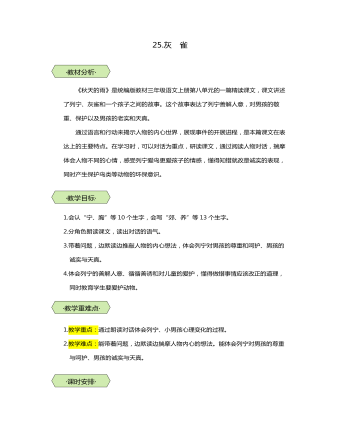
统编版三年级语文上第25课灰雀教学设计教案
《秋天的雨》是统编版教材三年级语文上册第八单元的一篇精读课文,课文讲述了列宁、灰雀和一个孩子之间的故事。这个故事表达了列宁善解人意,对男孩的敬重、保护以及男孩的老实和天真。通过语言和行动来揭示人物的内心世界,展现事件的开展进程,是本篇课文在表达上的主要特点。在学习时,可以对话为重点,研读课文,通过阅读人物对话,揣摩体会人物不同的心情,感受列宁爱鸟更爱孩子的情感,懂得知错就改是诚实的表现,同时产生保护鸟类等动物的环保意识。 1.会认“宁、胸”等10个生字,会写“郊、养”等13个生字。2.分角色朗读课文,读出对话的语气。3.带着问题,边默读边推敲人物的内心想法,体会列宁对男孩的尊重和呵护、男孩的诚实与天真。4.体会列宁的善解人意、循循善诱和对儿童的爱护,懂得做错事情应该改正的道理,同时教育学生要爱护动物。 1.教学重点:通过朗读对话体会列宁、小男孩心理变化的过程。2.教学难点:能带着问题,边默读边揣摩人物内心的想法。能体会列宁对男孩的尊重与呵护、男孩的诚实与天真。 2课时
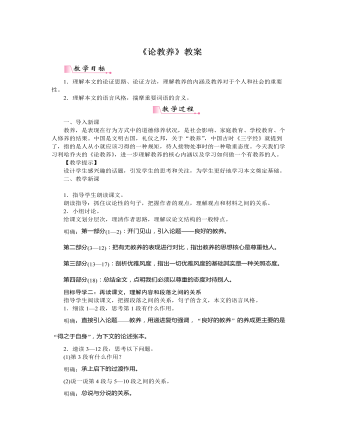
部编版语文九年级上册《论教养》教案
一、导入新课教养,是表现在行为方式中的道德修养状况,是社会影响、家庭教育、学校教育、个人修养的结果。中国是文明古国,礼仪之邦,关于“教养”,中国古时《三字经》就提到了,指的是人从小就应该习得的一种规矩,待人接物处事时的一种敬重态度。今天我们学习利哈乔夫的《论教养》,进一步理解教养的核心内涵以及学习如何做一个有教养的人。【教学提示】设计学生感兴趣的话题,引发学生的思考和关注,为学生更好地学习本文奠定基础。二、教学新课目标导学一:初读课文,理清层次1.指导学生朗读课文。朗读指导:抓住议论性的句子,把握作者的观点,理解观点和材料之间的关系。2.小组讨论。给课文划分层次,理清作者思路,理解议论文结构的一般特点。明确:第一部分(1—2):开门见山,引入论题——良好的教养。第二部分(3—12):把有无教养的表现进行对比,指出教养的思想核心是尊重他人。第三部分(13—17):剖析优雅风度,指出一切优雅风度的基础其实是一种关照态度。

初中语文常考常见的别词、别字教案教学设计
1、三年的汗水,终于有了回报。站在领奖台上,她兴奋得不能自己,泪水刷刷地流了下来。误:不能自己 正:不能自已[bù néng zì yǐ] 2、灯光下面,人头攒动。这条街上陈列的,其实大都是膺品,但还是热闹非凡。误:膺品 正:赝品[yàn pǐn]3、待学生从农村基地回来时,校舍已修茸一新,三幢大楼披上了节日的盛装。误:修茸 正:修葺[xiū qì] 4、埋伏在左侧的三连,听到冲锋号响,尤如猛虎下山,直扑敌人阵地。误:尤如猛虎下山 正:犹如猛虎下山[yóu rú] 5、粗制滥造,哄抬市价,这种竭泽而鱼的做法,最后必然会让自己受到惩罚。误:竭泽而鱼 正:竭泽而渔[jié zé ér yú] 6、自从钢琴热掀起后,钢琴教师身价倍增,一批“三脚猫”也混迹其中,滥芋充数。误:滥芋充数 正:滥竽充数[làn yú chōng shù] 7、阳光穿射而入,配着店堂排列得整整齐齐的书架,真是一个书香花香阳光普照的世外桃园。误:世外桃园 正:世外桃源[shì wài táo yuán]8、在调查过程中,陈又将大批赃款转移至岳父处,专案组找他谈话时,他依旧装得若无其事。误:脏款 正:赃款[zāng kuǎn]
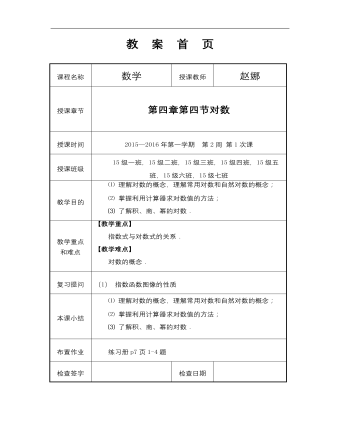
【高教版】中职数学基础模块上册:4.3《对数》优秀教案
课程名称数学授课教师赵娜授课章节第四章第四节对数授课时间2015—2016年第一学期 第2周第1次课授课班级15级一班,15级二班,15级三班,15级四班,15级五班,15级六班,15级七班教学目的⑴ 理解对数的概念,理解常用对数和自然对数的概念; ⑵ 掌握利用计算器求对数值的方法; ⑶了解积、商、幂的对数.教学重点 和难点【教学重点】 指数式与对数式的关系. 【教学难点】 对数的概念.复习提问(1) 指数函数图像的性质本课小结⑴ 理解对数的概念,理解常用对数和自然对数的概念; ⑵ 掌握利用计算器求对数值的方法; ⑶了解积、商、幂的对数.布置作业练习册p7页1-4题检查签字 检查日期

【高教版】中职数学基础模块上册:2.2《区间》优秀教案
【教学目标】1、掌握区间的概念;2、用区间表示相关的集合;3、通过数形结合的学习过程,培养学生的观察能力和数学思维能力。【教学重点】区间的概念【教学难点】 区间端点的取舍【教学设计】 1、实例引入知识,提升学生的求知欲;2、数形结合,提升认识;3、通过知识的巩固与练习,培养学生的思维能力【课时安排】 1课时(45分钟)【教学过程】² 创设情景 兴趣导入问题:资料显示:随着科学技术的发展,列车运行速度不断提高.运行时速达200公里以上的旅客列车称为新时速旅客列车.在北京与天津两个直辖市之间运行的,设计运行时速达350公里的京津城际列车呈现出超越世界的“中国速度”,使得新时速旅客列车的运行速度值界定在200公里/小时与350 公里/小时之间.如何表示列车的运行速度的范围??解决:不等式:200<v<350;集合:;数轴:位于200与3之间的一段不包括端点的线段;还有其他简便方法吗?
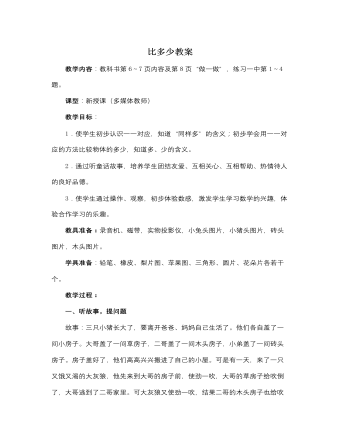
人教版新课标小学数学一年级上册比多少教案
4.操作。(“做一做”第2题) 全班同学动手操作,1名同学到投影仪上操作。 (1)第1行摆5个△,在△下面摆○,△要比○多1个。第2行摆几个○? (2)第1行摆4朵红花,摆的黄花比红花少1朵,第2行摆几朵黄花? 二、运用新知 教科书练习一第1~4题。 1.第1题:左图是猴子多,右图是骨头多。(避免学生产生思维定势) 2.第2题:学生观察,看到公鸡和鸭子虽然摆的一样长,但疏密不同,进而判断摆的密的鸭子的只数多些,而公鸡只数少些。 3.第3题:学生在观察到第一排蛋糕同样多的基础上,只需比较两盒中的第二排。第二排多的就多些,反之,就少些。 4.第4题:此题是在同一排中比较多少,当第5次循环出现珠子时,只出现了一个黄色珠子,所以黄珠子多而红珠子少。 三、总结 教师:今天我们学习了“比一比”,知道在比较时,一定要一个对着一个比,就会得到正确的结果。
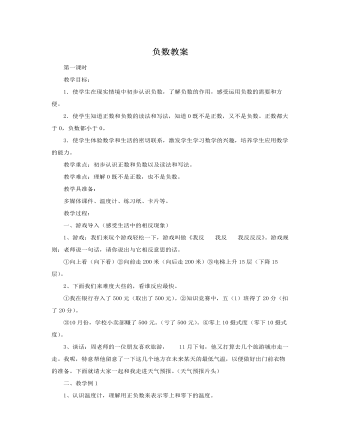
人教版新课标小学数学六年级下册负数教案
(3)教师在黑板上话好直线,在相应的点上用小图片代表大树和学生,在问怎样用数表示这些学生和大树的相对位置关系?(让学生把直线上的点和正负数对应起来。(4)学生回答,教师在相应点的下方标出对应的数,再让学生说说直线上其他几个点代表的数,让学生对数轴上的点表示的正负数形成相对完整的认识。(5)总结:我们可以像这样在直线上表示出正数、0和负数,像这样的直线我们叫数轴。(6)引导学生观察:A、从0起往右依次是?从0起往左依次是?你发现什么规律?B、在数轴上分别找到1.5和-1.5对应的点。如果从起点分别到.5和-1.5处,应如何运动?(7)练习:做一做的第1、2题。(二)教学例4:1、出示未来一周的天气情况,让学生把未来一周每天的最低气温在数轴上表示出来,并比较他们的大小。
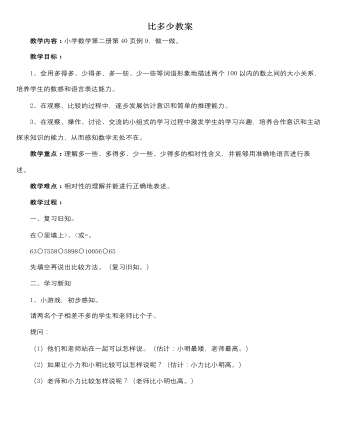
人教版新课标小学数学一年级下册比多少教案
教学目标:1、会用多得多、少得多、多一些、少一些等词语形象地描述两个100以内的数之间的大小关系,培养学生的数感和语言表达能力。2、在观察、比较的过程中,逐步发展估计意识和简单的推理能力。3、在观察、操作、讨论、交流的小组式的学习过程中激发学生的学习兴趣,培养合作意识和主动探求知识的能力,从而感知数学无处不在。教学重点:理解多一些、多得多、少一些、少得多的相对性含义,并能够用准确地语言进行表述。教学难点:相对性的理解并能进行正确地表述。教学过程:一、复习旧知。在O里填上>、<或=。63O7558O5898O10056O65先填空再说出比较方法。(复习旧知。)
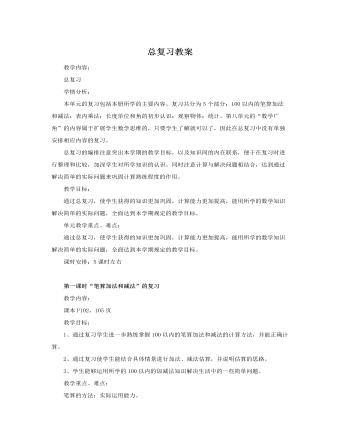
人教版新课标小学数学二年级上册总复习教案
教学内容:课本P104、108页。教学目标:1、通过复习使学生加深了解统计的意义。2、巩固学生对条形统计图的认知,明确用1格表示2个单位的表现形式,能根据统计图提出问题。3、在学习过程中培养学生的实践能力与合作意识。教学重点、难点:1、在复习中进一步了解统计的意义,加深对条形统计图的认识。2、能根据条形统计图的条件提出数学问题。教学过程:一、复习统计1、观察讨论(1)、教师出示条形统计图:这张图叫什么名字?它有什么作用?仔细观察统计图你有哪些发现?(2)、学生观察讨论,思考,依据自己的体验回答。仔细观察统计图,在小组内交流自己的发现。(3)、组织全班汇报交流,梳理统计图信息。2、回答问题根据条形统计图上的信息,你能回答下列问题吗?1)、最受二年级同学欢迎的饮料是什么?你是怎么看出来的?2)、喜欢哪两种饮料的人数同样多?你是怎么知道的?
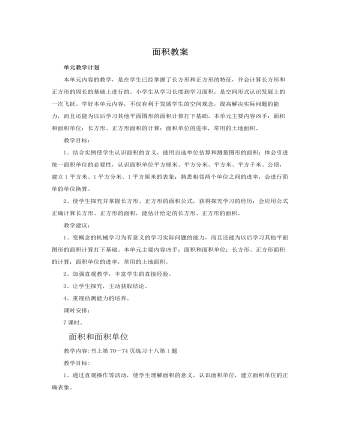
人教版新课标小学数学三年级下册面积教案
教学内容:书上第84页公顷、平方千米教学目标:1、让学生知道公顷、平方千米是更大的面积单位,了解1公顷、1平方千米的实际大小。2、知道1公顷=10000平方米,1平方千米=100公顷。3、培养学生的空间观察和动手操作能力,培养学生的爱国主义情感。教学重点:使学生了解1公顷、1平方千米的大小。掌握土地面积单位间的进率。教学难点:建立1公顷及1平方千米的实际概念,能区分两个单位。教学准备:课件教学过程:一、巩固旧知,作好铺垫。1、常用的面积单位有哪些?2、用打手势表示一下1平方厘米、1平方分米、1平方米的大小。3、填写正确的面积单位:指甲的面数学书本的封面黑板的面二、引入:同学们,我们一起来看看体育场的图片,你们有什么感想?出示:(体育场太大了)那还能用我们前面学过的面积单位进行测量吗?这就是我们今天要学的比平方米更大的面积单位:公顷和平方千米。(出示课题:公顷、平方千米)三、新授1、通常我们在测量土地面积时,要用到更大的面积单位,公顷和平方千米。它们到底有多大呢?这节课我们就来了解一下。
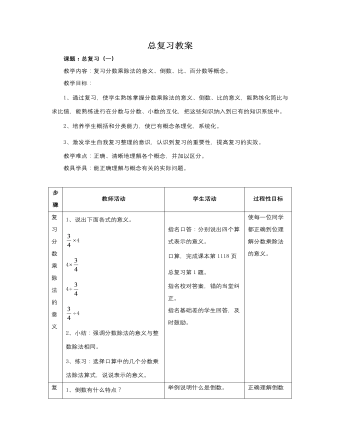
人教版新课标小学数学六年级上册总复习教案
出示:1、某校有男生500人,女生有450人,女生是男生的百分之几?你能把这道题改编成另外二道一步计算的百分数应用题吗?2、某校有男生500人,女生人数是男生的90%,女生有多少人?3、某校有女生450人,是男生的90%,男生有多少人?师:你觉得这三题有什么相同的地方和不同的地方?同:都以男生的人数为单位“1”异:条件与问题不同出示:1、完成书本124页第14题。2、2000年我国农村居民人均纯收入为2253元,1999年为2210元。2000年比1999年增长百分之几?3、一本书有240页,小林第一天看了 ,第二天看了12.5%,第三天应该从第几页看起?4、边长1厘米的正方形面积比边长2厘米的正方形面积少百分之几?5、修一条公路,实际造价84万元,比原计划增加了5%,增加了多少万元?出示:1、花园小学五年级男生有150人,女生人数是男生的 ,已知五年级人数占全校学生人数的25%。全校有多少名学生?2、书本124页第15、16、17题。
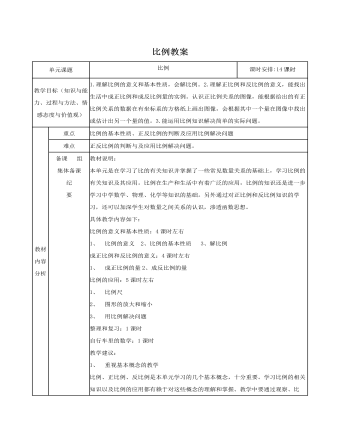
人教版新课标小学数学六年级下册比例教案
一、回顾旧知,复习铺垫1、上节课我们学习了一些比例的知识,谁能说一说什么叫做比例?比例的基本性质是什么?应用比例的基本性质可以做什么?2、判断下面每组中的两个比是否能组成比例?为什么?6:3和8:4 : 和 :3、这节课我们继续学习有关比例的知识,学习解比例。(板书课题)二、引导探索,学习新知1、什么叫解比例?我们知道比例共有四项,如果知道其中的任何三项,就可以求出这个比例中的另外一个未知项。求比例中的未知项,叫做解比例。解比例要根据比例的基本性质来解。2、教学例2。(1)把未知项设为X。解:设这座模型的高是X米。(2)根据比例的意义列出比例:X:320=1:10(3)让学生指出这个比例的外项、内项,并说明知道哪三项,求哪一项。根据比例的基本性质可以把它变成什么形式?3x=8×15。这变成了什么?(方程。)教师说明:这样解比例就变成解方程了,利用以前学过的解方程的方法就可以求出未知数X的值。
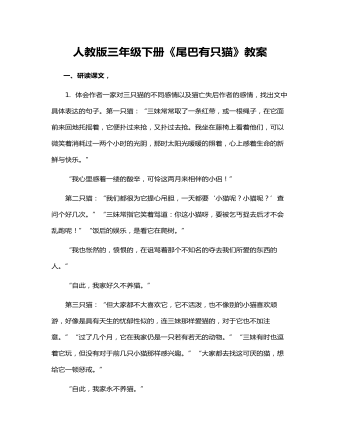
人教版三年级下册《尾巴有只猫》教案
一、研读课文,1. 体会作者一家对三只猫的不同感情以及猫亡失后作者的感情,找出文中具体表达的句子。第一只猫:“三妹常常取了一条红带,或一根绳子,在它面前来回地托摇着,它便扑过来抢,又扑过去抢。我坐在藤椅上看着他们,可以微笑着消耗过一两个小时的光阴,那时太阳光暖暖的照着,心上感着生命的新鲜与快乐。”“我心里感着一缕的酸辛,可怜这两月来相伴的小侣!”第二只猫:“我们都很为它提心吊胆,一天都要‘小猫呢?小猫呢?’查问个好几次。”“三妹常指它笑着骂道:你这小猫呀,要被乞丐捉去后才不会乱跑呢!”“饭后的娱乐,是看它在爬树。”“我也怅然的,愤恨的,在诅骂着那个不知名的夺去我们所爱的东西的人。”“自此,我家好久不养猫。”第三只猫:“但大家都不大喜欢它,它不活泼,也不像别的小猫喜欢顽游,好像是具有天生的忧郁性似的,连三妹那样爱猫的,对于它也不加注意。”“过了几个月,它在我家仍是一只若有若无的动物。”“三妹有时也逗着它玩,但没有对于前几只小猫那样感兴趣。”“大家都去找这可厌的猫,想给它一顿惩戒。”“自此,我家永不养猫。”第一只猫“很活泼”,“我看着三妹逗猫玩的融副泄泄的生活情景,感着生命的新鲜与快乐”,当猫无故病死后“可怜这两月来相伴的小侣”并为之“酸辛”;当第二只“更有趣,更活泼”的猫在周围邻居冷漠的观望中被那些“过路人”捉走后就“怅然”、“愤恨”、“诅骂”,在这段生活经历中展示的“我的人性”充满爱心,表现得十分宽容、温馨、善良和光明。然而在“芙蓉鸟事件”发生后的“我”,不仅只凭主观猜测“妄下断语”,面对猫这个弱小、可怜的动物怒气冲天“拿木棒追打”、“心里还愤的,以为惩戒的还没有快意”,人在动物面前恃强凌弱,则充分暴露了人性中凶恶、冷酷、残暴和阴暗的一面。不过,当“我”明白这只丑猫并非是罪魁祸首后,良心受到了谴责。2. 说说为何“我”对第三只猫的死比前两只猫的亡失“更难过得多”?第二只猫丢失后,作者写道:“自此,我家好久不养猫。”第三只猫死后,作者又写道:“自此,我家永不养猫。”试着联系课文中的描写,体会这两句话中包含的思想感情有什么不同?因为第三只猫的死责任在“我”。我们的主观臆断,断定鸟是它咬死的,暴怒之下“我”用木棒打它,它受到冤苦无处辩诉,最后死在邻家屋檐上。“我”认为是“我”把它害死的,而且这个过失是无法补救的。这句话在内容上是对全文的总结。“我”目睹了前两只猫的不幸后,又亲自制造了第三只猫的悲剧,深感负疚,为了不再看到这样的悲剧重演下去,“自此,我家永不养猫”这句话与文章的开头遥相呼应,在结构上形成了首尾呼应的特点。
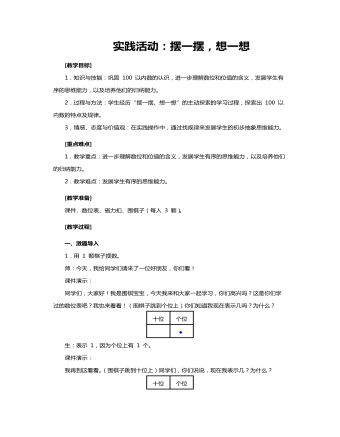
人教版一年级数学《实践活动摆一摆,想一想》教案
[教学目标]1.知识与技能:巩固 100 以内数的认识,进一步理解数位和位值的含义,发展学生有序的思维能力,以及培养他们的归纳能力。2.过程与方法:学生经历“摆一摆、想一想”的主动探索的学习过程,探索出100 以内数的特点及规律。3.情感、态度与价值观:在实践操作中,通过找规律来发展学生的初步抽象思维能力。[重点难点]1.教学重点:进一步理解数位和位值的含义,发展学生有序的思维能力,以及培养他们的归纳能力。2.教学难点:发展学生有序的思维能力。[教学准备] 课件、数位表、磁力扣、围棋子(每人3 颗)。[教学过程]一、激趣导入1.用 1 颗棋子摆数。师:今天,我给同学们请来了一位好朋友,你们看!课件演示:同学们,大家好!我是围棋宝宝,今天我来和大家一起学习,你们高兴吗?这是你们学过的数位表吧?我也来看看!(围棋子跳到个位上)你们知道我现在表示几吗?为什么?生:表示 1,因为个位上有 1 个。
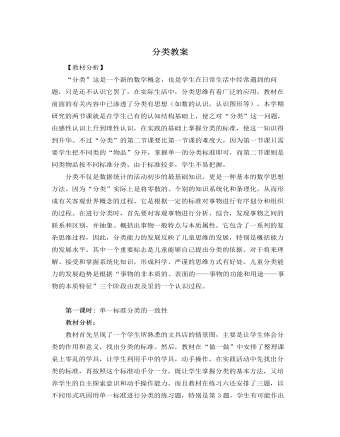
人教版新课标小学数学一年级上册分类教案
教学目标:1.能选择不同的标准对同一类物品进行不同的分类,掌握分类的方法。2.初步感知不同标准分类的意义,体验分类结果在不同标准下的多样性。3.培养学生思维的灵活性和发散性,养成良好的学习、生活习惯。4.培养学生的操作能力、观察能力、判断能力、语言表达能力和合作交流的意识。5.让学生体会到生活中处处有数学,学会用学到的知识解决生活中的实际问题。教学重、难点:重点:选择不同标准分类难点:思维的发散性 关键:在直观中拓展思维的时空教学准备:铅笔、实物卡片、学具袋(各种形状、颜色各异的物品)教学过程:一、观察分析 多重分类1.师出示如书本P39页的铅笔。(1)观察这些铅笔有什么不同?并把它们分分类。(2)四人一小组交流、讨论可以怎么分类?是按什么分的?比比哪一组的分法最多。

